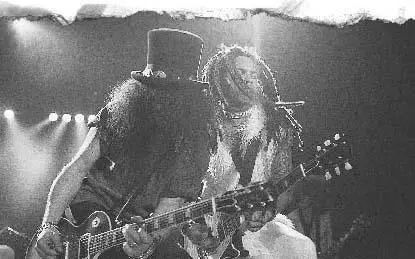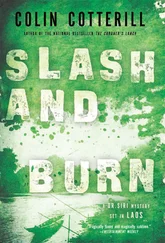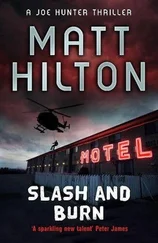The first recording with Matt was “Knocking on Heaven’s Door,” for the Days of Thunder soundtrack (which also ended up on the Illusions albums). I remember doing the solo for it on my way somewhere and I used a ’58 Gibson Explorer. It was an amazing take, I just ran in there with my girlfriend and some friends in tow, picked up the guitar, and really let the solo sing : I turned the tone down on the bass pickup, I locked in and let it scream . I really love the way that one came out—it was very emotional yet effortless.
“Knocking on Heaven’s Door” was also the first song that we could listen to and get an idea of what the band sounded like with our new drummer. It came out great, but there was a definite difference in the overall feel of the new Guns from the old Guns. We had lost a little bit of the mayhem and punk rock, that raw chaotic, seat-of-the-pants feel. Instead we sounded more epic and solid and huge. That was a good or a bad thing depending on who you asked. In my opinion, I was just happy to be moving ahead.
Next, we went in and Matt learned all thirty-six songs at breakneck speed, basically by playing them with us live because there was no other material to reference. We booked ourselves into A&M in Hollywood and recorded thirty-six songs in thirty-six days. Between takes, we’d go to Crazy Girls, the strip bar across the street, which I’m sorry to say is no longer there. At night we’d go out carousing, then show up the next afternoon and do it all again on a new song. It was a great thirty-six days, during which Duff and I realized that Matt was both an incredible drummer and our brand-new party buddy. Before the drug thing got out of hand and before the incident with Steven, there were some dark periods, but we’d come through that: we were now very functional alcoholics and occasional coke users. Actually, I doubt that it was occasional—Matt and Duff did a lot of blow. I didn’t do as much, but it didn’t matter because, like them, I’d built up my tolerance of everything to the point that we were all a perfectly productive, chemically driven, and very professional band.

Beverly Hills High should be proud: Slash onstage with Lenny Kravitz.
I WAS GETTING OUT THERE AND CIRCULATING a lot more, too, by this point. Duff and I ran into Iggy Pop during our down time and he asked us to play on Brick by Brick . We went down to meet him at the Rainbow, where we got into his car and listened to the demos, which was very cool. Iggy is Duff’s ultimate hero and there was a little bit of history there on my end because of Bowie—he and my mom had gone to visit Iggy at the Cedars psych ward. We showed up in Hollywood and laid down some tracks with him: “Home Boy,” “Pussy Power,” and a song that Iggy and I cowrote, “My Baby Wants to Rock ’n’ Roll.” It was one of the most fun sessions I’d ever done. Not long after that, we also did the video with him for “Home Boy.”
This was a real honor for us; it was another sign that Guns was getting back out on the scene and that we were being taken seriously as musicians. People wanted to see us plain and simple. At that point in 1990, Appetite and Lies had become huge commercial successes. This newfound attention also drew the spotlight to me as a guitar player, which took the form of a few calls to our management office. It was flattering to discover that other musicians had started to give me credit for being a fairly good guitar player.
One collaboration I did at the time was with Lenny Kravitz. I already knew him; he and I attended Beverly Hills High at the same time, and although I was in continuation while he was a regular student, we were the only two half-black half-white musicians in the school that I knew of. Duff and I were fans, and our favorite record of the moment was Lenny’s debut, Let Love Rule . When we were introduced at some awards function, I was ecstatic when he asked me to play on his next record, Mama Said, which he was in the midst of writing. Shortly thereafter we met up in a little studio on Robertson in L.A. where I put a solo on “Fields of Joy .” As I was warming up in the lounge that day, I played a funky guitar riff that I’d come up with recently but hadn’t found a place for in any of the songs I was working on at the time with Guns. It was just another of my exercises at the time.
“Hey man, what is that? ” Lenny asked
“I don’t know… Just something,” I said. “It’s too funky for Guns, but I like it. It’s cool.”
“Yeah, man. Don’t forget it. Bring that into the rehearsal room,” he said. “Let’s work on it. I’d like to write some lyrics to it.”
When it came time to actually write and record the song, Lenny flew me out to New York. He lived in Manhattan but he’d set himself up in a studio across the river in Hoboken, New Jersey. It was where he’d recorded his debut album, and where he was doing the basic tracks for his next album. We took the train there from his apartment, and he played drums while I laid the guitar down for what became “Always on the Run.” It was a lot of fun, very raw and stripped down, the way it should be done. There’s not a lot going on on that track, but it sounded really good; he put the bass and vocals on later. The studio was like Lenny’s castle; every instrument was in place—he could jump from guitar to bass to drums and get it all down as his inspiration dictated.
I had brought Renee with me on that trip and we were staying in midtown at a hotel close to Lenny’s apartment and had spent the night before, a Saturday, carousing extensively. It was summertime, it was hot as hell, and once I got to Lenny’s place that Sunday morning, I discovered that due to some outdated rule called the “blue law” on New York’s books, no bars or liquor stores were open at all.
It wasn’t exactly how I pictured this collaboration going down and it was about to be a problem. I remember hanging around Lenny’s apartment waiting for him to get ready. The place looked like the world’s biggest closet of vintage clothes had vomited all over the room: there were garments everywhere, covering every available surface. It was ten a.m., I was taking this whole scene in, and I was craving a drink.
“Hey man, do you have anything to drink?” I asked.
“No, man, I don’t think so,” Lenny said. “You want to smoke a joint?”
“That’s cool. I could really use a drink, though,” I said. “Can we stop by a bar or a liquor store on the way?”
“I don’t know, man,” he said. “I don’t think so. That’s all closed on Sunday.”
“Oh yeah?” I said, getting a little bit nervous. “Do your neighbors have any booze? I need a drink, man.”
Lenny did his best; he procured what seemed like a thimbleful of vodka from his neighbor. I downed it but it was like throwing a Band-Aid at a gunshot wound. As we hopped on the PATH train to Hoboken, which is a trip of about twenty minutes, I began to experience alcohol detox: my hands shook, I was light-headed, irritable, and anxious. It wasn’t some big mystery—I just needed a fucking drink, like now . My reserve of civility was equally dry.
“Hey Lenny, man, we have to find some vodka right away,” I said. “I can’t play unless I get a fucking drink.”
Lenny could relate to a degree, I suppose: he needed his pot to create and write music—the only difference was that his body didn’t malfunction if he didn’t have it. Every bar on the way looked like they’d not been open since 1955. When we got to his studio, Lenny sent his people out in search of booze. I’m not sure how they got it, but they returned with some vodka around twelve, and once they did, we settled in. We recorded “Always on the Run” in under an hour; the raw, spontaneous energy of that track is right there in the final product.
Читать дальше
Конец ознакомительного отрывка
Купить книгу





![Сол Слэш Хадсон - Slash. Демоны рок-н-ролла в моей голове [litres]](/books/387912/sol-slesh-hadson-slash-demony-rok-n-thumb.webp)


